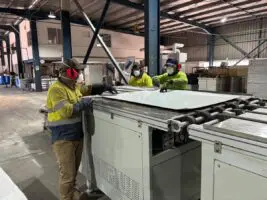As political minds were focused on Saturday at the outcome of the Senate re-run in Western Australia, and what that might mean for the Abbott government’s carbon repeal legislation and the future of the Clean Energy Finance Corporation, the newly appointed renewable energy target (RET) review panel quietly released a discussion paper and a call for submissions.
Included in the discussion paper are considerations to remove incentives for small scale technologies (solar PV), and to consider whether non-specified “non renewable”, low emissions technologies should be included in the large scale target (suggesting gas or carbon capture and storage).
The review panel – controversially led by self-proclaimed climate skeptic Dick Warburton – wants feedback to its discussion paper (and the modeling assumptions included in it) by the end of next week. Formal submissions to its review are due in mid May. It says stakeholder meetings will be held over the next two months, with a workshop on its modelling assumptions to take place in the holiday week between Easer Monday and Anzac Day. The final report will be handed to the Environment and Energy ministers, but will also be filed directly to the PM’s department, which is providing secretarial support.
As expected, the review is focused mostly on the costs of the RET – both large scale and small scale, its impact on incumbent generators and networks, and the ability to actually meet the current 41,000GWh fixed target.
The RET review is absolutely crucial for the future of both large scale generation and rooftop solar and other small scale technologies in Australia. The federal government has come under intense pressure – from incumbent utilities and some business lobby groups and state governments – to either scrap the RET entirely, or at least dilute it.
The discussion paper – released on Saturday afternoon – says these proposals will be considered, along with the question of whether support for small-scale solar should be withdrawn, and whether the small scale and large scale schemes should be combined.
The key questions to be addressed will include these:
Should the LRET be abolished, reduced or increased? If retained, what level should it be? What would the impact of such changes be?
Do small-scale renewable energy systems still require support through the SRES? If so, for what period will support be required for?
Should the LRET and SRES schemes be recombined?
What impact is the RET having on electricity markets and energy markets more broadly? How might this change over time?
The review will also look at the government’s wish to include energy generated from the waste of native forests to be included, and other non-specified non-renewable “low emission” generation technologies.
This reference is clearly beyond the much-lobbied for inclusion of fuel cells in the small scale target, because it refers specifically to the large scale component.
“Should any other energy sources be included in the LRET? Should any non-renewable (but low emissions) energy sources be included?”
It does not suggest which technologies this could include, and an email to the environment minister’s media people went unanswered. It could be a push to include carbon capture and storage, or it could be a push for gas. Some commentators and industry groups have pushed for gas to be included in a broader “clean energy target”. The push for this has intensified in the light of surging gas prices, which has forced gas generation to be curtailed, or focused only on peaking power.
The review will also look at the abatement cost of the scheme, how it might fit in with the government’s proposed Direct Action policy, and other schemes such as energy efficiency.
Interestingly, the report cites little material – and none of the conclusions – included in the review conducted by the Climate Change Authority, which completed its own assessment 15 months ago and rejected incumbent calls for the target to be diluted.
The discussion paper notes that about $18 billion of investment has been stimulated by the RET, resulting in 24,000 jobs. Nearly two thirds of this investment, and more than two thrds of jobs, have come from small scale solar PV and solar hot water.
But, it says, “the impact of the RET is not spread uniformly across society. While some households have benefited directly from the installation of small-scale technologies, all electricity consumers share the costs of the RET through their electricity bills.
“In addition, increasing electricity prices are disproportionately felt by low-income households. These households spend a greater proportion of their income on domestic fuel and power and may face a range of barriers to accessing more efficient appliances and small-scale renewable technology.”
It also quotes an estimate from SKM that suggested the cost impact of the RET for an average small and medium sized business consuming 140 MWh of electricity is about $337 per year over the period 2013 to 2031. And, it says, the introduction of large amounts of small scale solar could have implications for non solar users as networks seek to recover costs lost in falling volumes.
There is no mention of the potential benefits of solar in reducing wholesale prices or deferring network expansion.
It also notes that about 10,000MW of new large scale renewable capacity will be needed to meet the current 41,000GWh target, requiring a “significant increase” in the amount of new capacity each year, and (because it estimates almost all of this will come from wind farms) potentially cause “operational challenges” for market operators.
It also notes that given electricity demand is falling, the introduction of new generation capacity is reducing the market share for incumbent generators and “may contribute to fossil fuel generators being mothballed or curtailed.” Already, some 2,250MW of coal fired generation has been closed or mothballed since 2012, and that could rise to more than 3,100MW.
It says that that the RET has the “potential” to influence wholesale electricity prices – although almost every incumbent generators and energy analyst would suggest its downward pressure on wholesale prices is indisputable. The discussion paper says that modelling commissioned as part of the review will provide estimates of the overall effect of “different LRET targets” and the impact this may have on household electricity bills.









